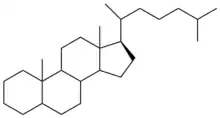甾
See also: 畄 and 𤰝
| ||||||||
| ||||||||
Translingual
Han character
甾 (radical 102, 田+3, 8 strokes, cangjie input 女女田 (VVW), four-corner 22600, composition ⿱巛田)
Derived characters
References
- KangXi: page 759, character 11
- Dai Kanwa Jiten: character 21742
- Dae Jaweon: page 1169, character 11
- Hanyu Da Zidian: volume 4, page 2531, character 5
- Unihan data for U+753E
Chinese
| simp. and trad. |
甾 | |
|---|---|---|

The basic structure of steroids (甾), featuring the tetracyclic backbone with three side chains.
Glyph origin
| Characters in the same phonetic series (甾) (Zhengzhang, 2003) | |
|---|---|
| Old Chinese | |
| 輜 | *ʔsrɯ, *sʰrɯ |
| 淄 | *ʔsrɯ |
| 錙 | *ʔsrɯ |
| 緇 | *ʔsrɯ |
| 甾 | *ʔsrɯ |
| 菑 | *ʔsrɯ, *ʔsɯː, *ʔsɯː |
| 鶅 | *ʔsrɯ, *ʔsrɯs |
| 椔 | *ʔsrɯ, *ʔsrɯs |
| 鯔 | *ʔsrɯ |
This character is a fusion of two characters which were separate in small seal script.
- “earthenware”
- 甾 of this sense was 𠙾-like in the small seal script, with three vertical straight strokes on top, representing the pictogram (象形) of a bambooware. This became the current form in the clerical script.
- This glyph was used as 載 (OC *zlɯːs) or proper nouns in oracle bone script.
- “one-year field”
- The glyph of this sense is composed of 𡿧 (“calamity”) and 田 (OC *l'iːŋ, “field”). This glyph is also used as an alternative form of 災 (OC *ʔslɯː).
- “steroid”
- This character was practically obsolete before it was revived as a modern translation for steroid. It is also a pictogram (象形) in this sense; the upper part represents the three side chains on the ring system, and the 田 component represents the tetracyclic core of steroids. See the image on right.
Pronunciation 1
Definitions
甾
Compounds
|
|
|
Pronunciation 2
Definitions
甾
Japanese
Kanji
甾
- This term needs a translation to English. Please help out and add a translation, then remove the text
{{rfdef}}.
Korean
Vietnamese
Han character
甾 (tai)
- This term needs a translation to English. Please help out and add a translation, then remove the text
{{rfdef}}.
This article is issued from Wiktionary. The text is licensed under Creative Commons - Attribution - Sharealike. Additional terms may apply for the media files.